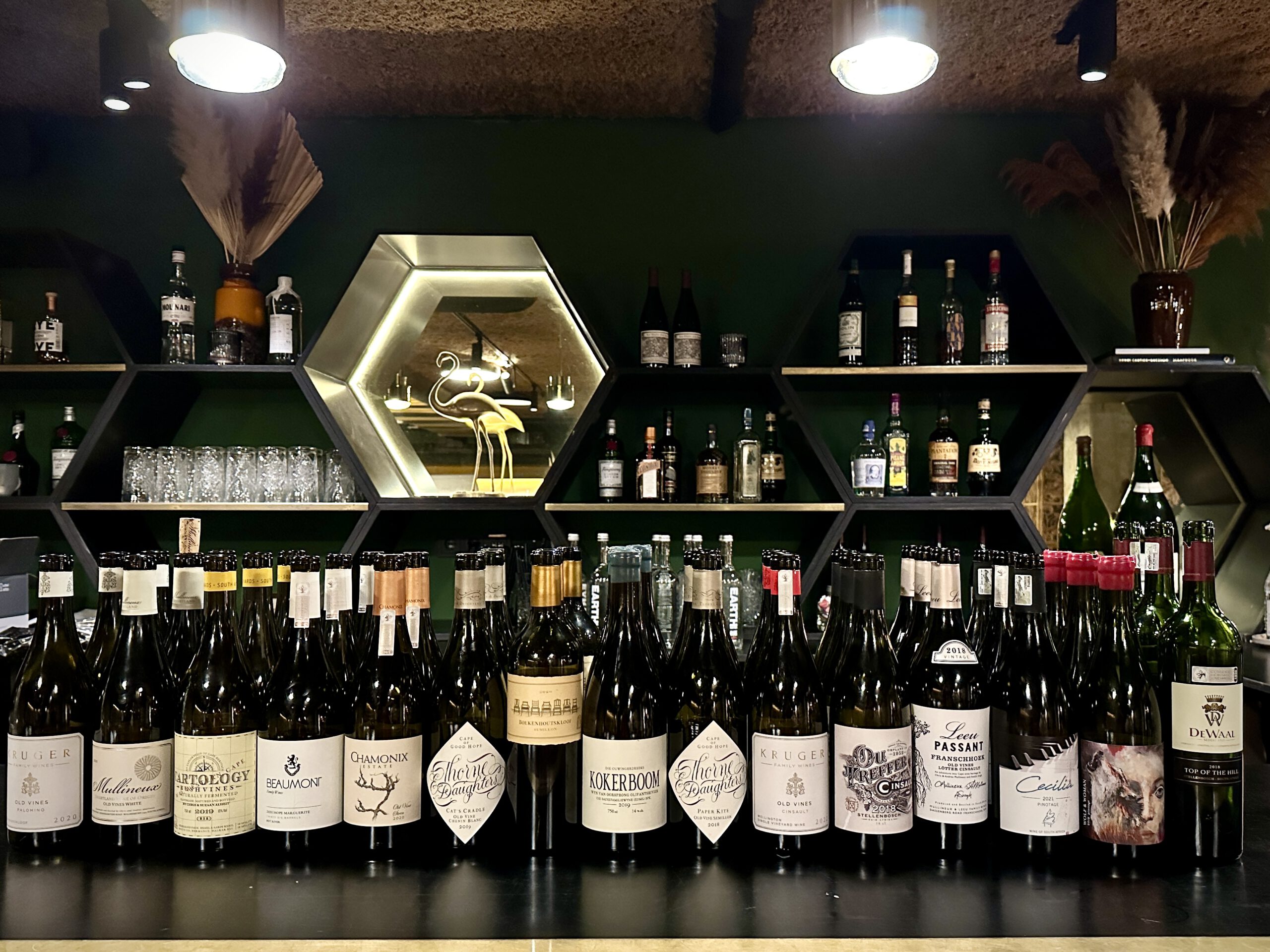Old Vines: Symbol of Quality or Marketing Hype?
You may have encountered the enticing term “Old Vines” or its equivalents like “Vieilles Vignes” (French), “Alte Reben” (German), and “Viñas Viejas” (Spanish) on wine labels. They sound appealing, but what do they actually mean? Is there a distinctive difference in taste or quality compared to regular wines, or is it merely a marketing gimmick?
Recently, we had the chance to explore the concept of South African old vines, in a Masterclass organized by Udo Göebel MV (wine importer at WineMatters).
Together with Andrea Mullineux (winemaker at Mullineux & Leeu) and the Old Vine Project (OVP), we focused on 15 old vine wines, from various producers, and learned more about the South African view on Old Vines.
This article seeks to unravel the enigmatic concept and reviews of the wines crafted from old vines that we tasted during the masterclass.
What are Old Vines?
Typically, young vines up to approximately five years old don’t establish a robust root system, yielding relatively less. Depending on the grape variety and growing conditions, vines between 10 to 40 years produce maximum yields of fruits, and then beyond that age, the vines tend to reduce the yield. Most of the vines are replanted after that, while growers may choose to keep the best vines for an extended period. Sometimes, vines are left untouched and eventually become what is referred to as old vines. The term ‘Old Vine’ is not regulated globally, so one producer may consider 30 years old while another may label 100 years old.
Currently, vines aged 35 and older are designated as old vines in South Africa. The country stands out for its extraordinary management of old vines, which is centrally controlled. Starting from the management by the KWV, the giant cooperative that used to be dominant before the apartheid era, vine ages is still centrally managed by registering all the information on planting and replanting.
There is a prevailing notion that old vines produce superior fruits, but it’s not always true. Generally, old vines are stable, ripening slowly and evenly and producing concentrated fruits; they don’t need many resources, including water or nutrients, as they can preserve energy resources in their body (trunk or root); they produce small or fewer grapes yet concentrated. However, they require more care for their health; for instance, old vines are more susceptible to trunk diseases. So, it is crucial to note that they demand meticulous care for their well-being. On the other hand, cultivating future old vines also requires appropriate care, such as using completely virus-free vines.
Sharing information among producers and educating newcomers plays a crucial role in preserving the health and vitality of old vines. The OVP in South Africa takes charge of this aspect. Initiated in 2002 by Rosa Kruger, OVP is a non-profit organization that certifies the planting dates of vineyards that are 35 years and older in South Africa. Presently boasting 130 members and over 300 vineyards, its growth continues. The organization’s multifaceted focus encompasses sharing information with nurseries to set up virus-free vines, educating winemakers and farmworkers to unlock the potential of old vines in producing high-quality wines, focusing on scientific research of vines and wines, and so on. OVP offers comprehensive support.
The extra effort into the old vine is essential when it comes to the quality, but it already shows some proof of the result. The chemical profiling of wines made between old vines and younger ones reveals the distinct variations in the results of Chenin Blanc, according to the research in the OVP. Wines made from old vines demonstrated more volatile compounds in the wines. (Ref: OVP Research)

Old Vines in South Africa
Let’s delve into some interesting facts about old vines in South Africa.
Looking at the different wine regions in South Africa ‘Stellenbosch’ is the largest source of old vines, followed by the Swartland and Paarl.

On a variety level there is also a clear winner. Chenin Blanc comprises half of all the old vines, making up nearly the same quantity as other varieties.
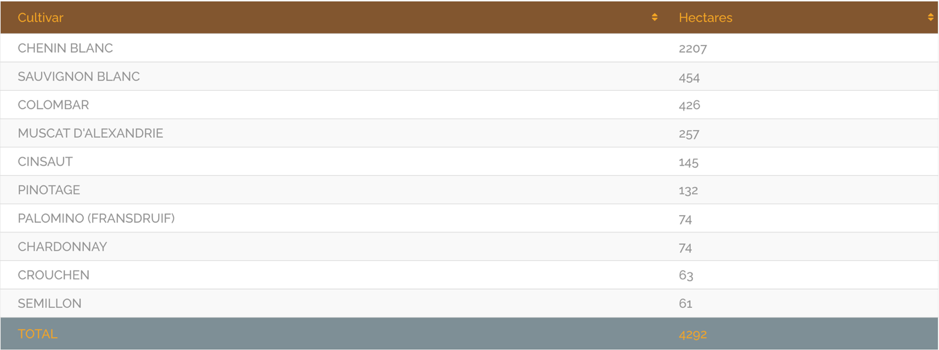
So, what are the oldest old vines? Surprisingly, vines dating back to 1900 (the date has been centrally recorded since 1900) still thrive in Wellington, Swartland, Breedekloof, and Franschhoek.
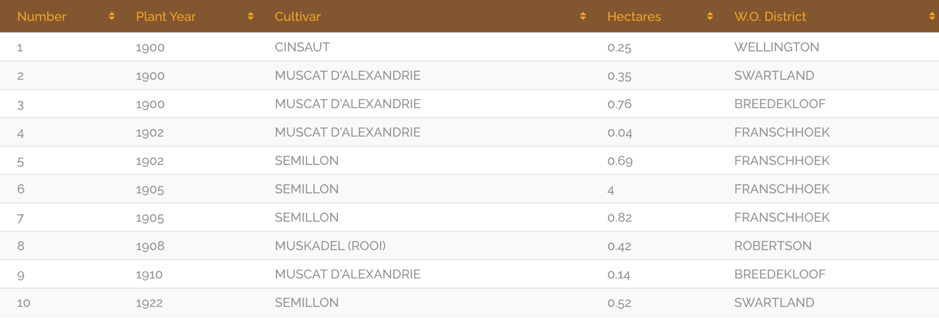
According to Andrea, old vines in South Africa make up 4-5% of all the vines, a percentage that has increased over the past couple of decades. The old vine age, with 35 years and older, is remarkable among others, with the average vine age of 20 years in South Africa.
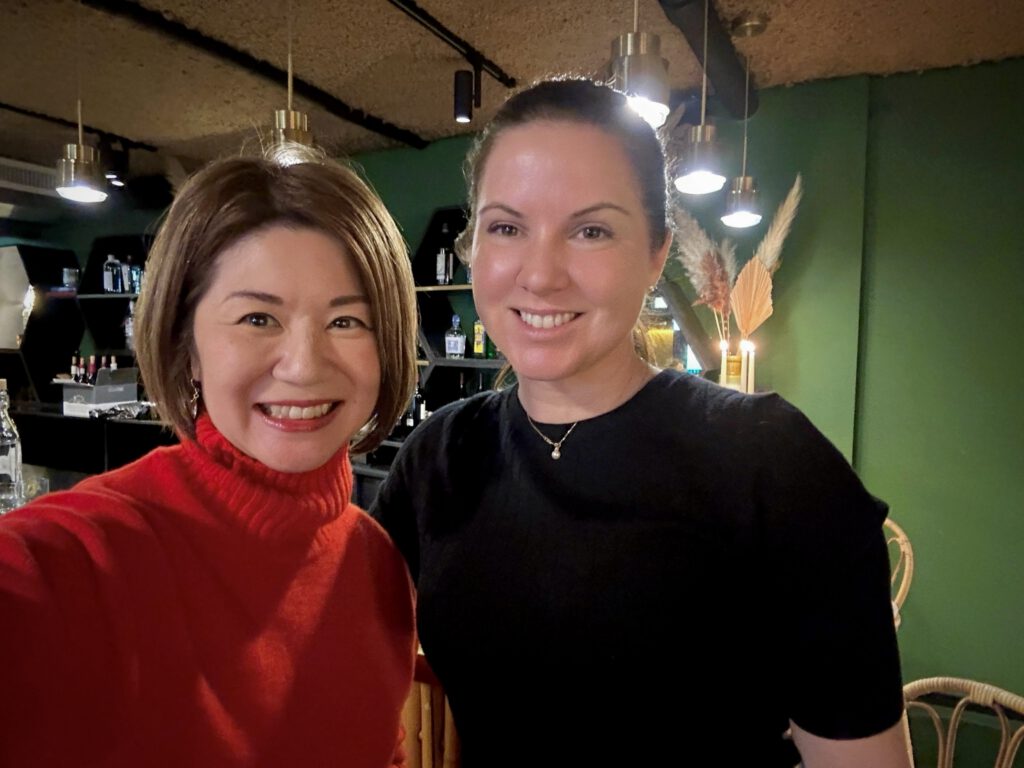
Some Great Old Vine Examples
So how does a wine made out of old vines taste? During the masterclass, we had the opportunity to taste 15 old vine wines made with various varieties, including Palomino, Chenin Blanc, Sauvignon Gris, Sémillon, Cinsault, and Pinotage, from multiple producers. Let’s look at some of those wines.
Palomino Old Vines ‘1974’ – Piekenierskloof | 2020 | Kruger Family Wines| 100% Palomino
Made from vines planted in 1974.
This wine boasts relatively expressive aromas, highlighting notes of apricot, peach, lemon zest, and fresh almond. The texture is rich, and the structure is upheld by refreshing high acidity, creating a fuller body on the palate—excellent concentration, showing complexity. The impressive persistence of its long finish adds to its allure.
Palomino once mainly used for distilled or fortified wines, has now been revived as a grape variety for high-quality still wines. An intriguing and distinctive variety.
We reward this Palomino wine with a 92-point DWA score.
Old Vines White – Swartland | 2021 | Mullineux & Leeu | 62% Chenin Blanc, 10% Clairette Blanche, 9% Viognier, 7% Grenache Blanc, 6% Semillon Gris, 6% Verdelho
Made from vines that are aged up to 67 years old.
The incredible texture and lively high acidity form its backbone, showcasing many layered fragrant aromas like white peach, citrus zest, grapefruit, blossom, pear, white pepper, and almond. A noted salinity and minerality on the palate with a satisfying finish.
Sémillon Gris is a unique variety in South Africa. Originally Sémillon, but their 40-70% naturally mutated to Sémillon Gris.
We reward this Swartland blend wine with a 93-point DWA score.
Cartology – Western Cape | 2019 | Alheit Vineyards | 90% Chenin Blanc, 10% Sémillon
Made from vines that are at least 30 years old, although most are between 40 and 50 years of age.
Expressive and layered aromas unfold, revealing notes of candied lemon, floral tones (a hint of elderflower), yeast, hazelnuts, clove, and honey on the nose. The palate boasts a richer body with weight in the mid-palate and remarkable intensity. It maintains a great length, complemented by refreshing acidity.
We reward this Chenin Blanc with a 92-point DWA score.
Semillon – Franschhoek | 2020 | Boekenhoutskloof | Mostly Semillon with Muscat d’Alexandrie
The wines were sourced from multiple vineyards planted in 1902, 1936, and 1942.
The nose is lively and enticing, revealing expressive aromas of apricot, pineapple, blossom, verbena, mandarin orange, sweet spice, citrus zest, flinty notes, wet pebble, beeswax, and petrol, showing complexity. This is a full-bodied, textured wine with a saline and taut finish.
We reward this Semillon with a 93-point DWA score.
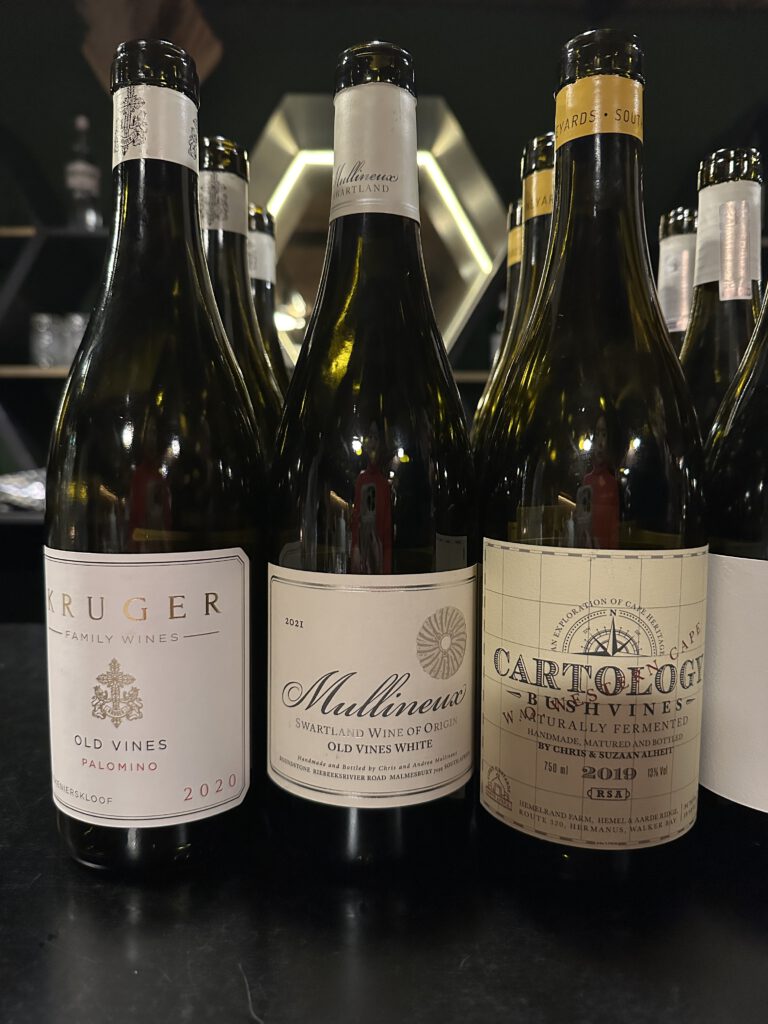
Kokerboom Semillon – Olifantsrivier (Skurfberg) | 2019 | Sadie Family Wines | 100% Semillon (80% Blanc + 20% Gris)
Made from vines planted in the 1930s.
Exceptional concentration and complexity shine through. Expressive aromas feature yellow pineapple, just-ripe apricot, green apple, citrus, spice, and a hint of chamomile. The nose is pure and focused on the fruit (yet not fruit-forward). The palate offers a full-bodied experience with weight in the mid-palate, yet it remains refreshing due to its vibrant acidity. Everything is beautifully balanced, showing elegance. It could show more complexity with aging.
We reward this Semillon with a 95-point DWA score, with potential to improve even further.
Paper Kite Semillon – Swartland | 2018 | Thorne & Daughters | 100% Semillon
Made from vines that are 56-years of age.
Excellent fruit concentration, showing aromas of quince, pink grapefruits, herbal, grass, white floral, vanilla, clove, and a hint of reductive note on the nose. Rich, textualized on the palate with umami and a savory impression.
We reward this Semillon with a 92-point DWA score.
Leeu Passant Old Vines Lötter Cinsault – Franschhoek | 2018 | 100% Cinsault
The wine comes from vines planted in 1932.
It strikes a fantastic balance between elegance and boldness. Succulent, crunchy mixed berries—wild strawberry, raspberry, with a hint of blackberries—take center stage—aging aromas featuring earth, a touch of meatiness, spices, and savory flavors contribute to its complexity. Structured by chewy yet ripe tannins and vibrant acidity, it delivers a harmonious, creamy mouthfeel on the palate. The wine concludes with a persistent, long finish.
We reward this Cinsault with a 94-point DWA score.
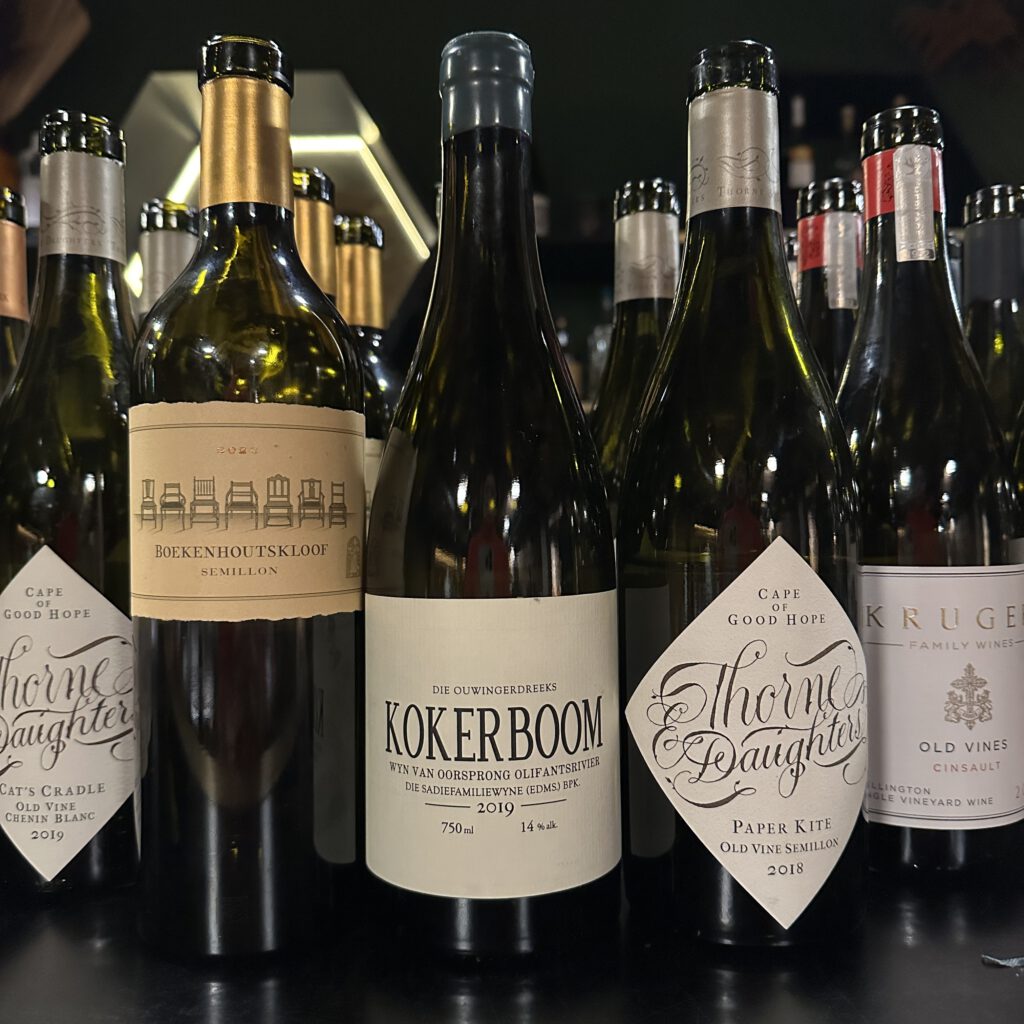
Uncorking Excellence: A Toast to Old Vines and South African Winemaking
The overall quality of wines made from old vines is surprisingly high, with some reaching truly exceptional levels. However, attaining this heightened quality demands more knowledge, time, and meticulous care both in yielding quality fruits and preserving old vines. In this endeavor, the role of the Old Vine Project proves to be crucial in education, information sharing, and research.
You may have noticed that South African wines are relatively inexpensive, given their quality level. Ensuring a continuous supply of high-quality wine from old vines at the right price supports farmers and winegrowers in achieving economic sustainability. For consumers it translates to the pleasure of being able to sustainably indulge in high-quality wines. In the meanwhile, we keep a close eye on the many beautiful old vine wines that are reaching us from South Africa.
About the host and organizer of this Masterclass
Udo Göebel MV, the proprietor of WineMatters, was the host of this masterclass. Udo possesses an immense passion for high-quality South African wines, particularly those from small family businesses. He embarked on his venture as an importer with WineMatters, eliminating middlemen and directly delivering these wines to wine enthusiasts. According to Udo, there has been a growing focus on old vines recently. Over the past two years, he has conducted wine tastings of Sémillon, recognizing their exceptional quality. This acknowledgment, coupled with his extensive knowledge of South African wines, has expanded the scope of this masterclass to include a broader range of wines.
Andrea, a crucial member of OVP, provided explanations together with Udo MV, elevating this masterclass to another level for a comprehensive understanding of old vines in South Africa.
We are grateful to Udo for this fantastic opportunity to delve into the world of old vines and share our insights with our readers. Furthermore, we are keen to keep an eye on the quality wines crafted by old vines.
Our own Kazumi Uejo has attended this masterclass and wrote this article. The reviewed wines are imported into the Netherlands by WineMatters and are directly available through their website.
If you are interested in learning more about old vines and the wines they bring forward we suggest this article by us, that discusses the Spanish old vines from Ribera del Duero.

